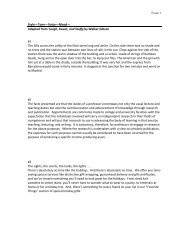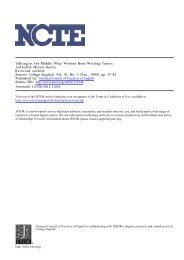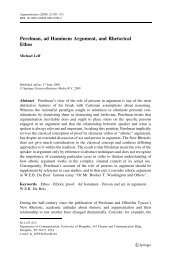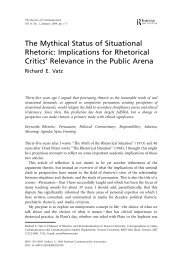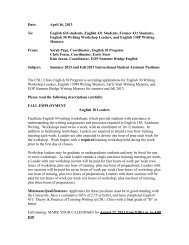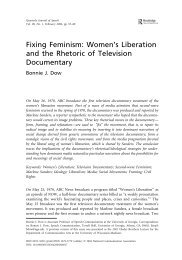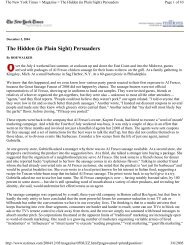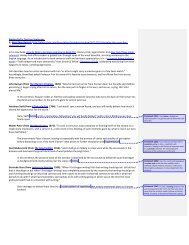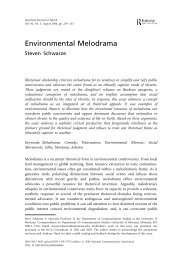Trimbur, “Peer Tutoring: A Contradiction in Terms?” - CompHacker
Trimbur, “Peer Tutoring: A Contradiction in Terms?” - CompHacker
Trimbur, “Peer Tutoring: A Contradiction in Terms?” - CompHacker
Create successful ePaper yourself
Turn your PDF publications into a flip-book with our unique Google optimized e-Paper software.
22 The Wnung Cence. journalPeer <strong>Tutor<strong>in</strong>g</strong>: A <strong>Contradiction</strong> <strong>in</strong> <strong>Terms</strong>! 23expectations don't backfire on them. I've seen it happen. Tutors are delicatemechanisms, without the protective coat<strong>in</strong>g and resiliency most of usdevelop as professionals. So there's the risk tutors' <strong>in</strong>itial expectations willbe shattered, lead<strong>in</strong>g to disappo<strong>in</strong>tment or even cynicism. When theirhopes are not realized, when tutor<strong>in</strong>g sessions don't go well or when tutees'grades don't go up, tutors may start to blame the students they work with.More often, the tutors blame themselves, and their feel<strong>in</strong>gs of <strong>in</strong>adequacycan turn <strong>in</strong>to a debilitat<strong>in</strong>g sense of guilt about not gett<strong>in</strong>g the job done.The problem, however, is not just the tutors' ego, <strong>in</strong>vestment. Theproblem concerns what the tutors have <strong>in</strong>vested their energy do<strong>in</strong>g. Tutors'<strong>in</strong>itial standards for def<strong>in</strong><strong>in</strong>g the aims and evaluat<strong>in</strong>g the results of tutor<strong>in</strong>gare predictably conventional ones, <strong>in</strong>formed by the prevail<strong>in</strong>g reward struc,ture that makes grades the central measure of success <strong>in</strong> higher education. Itcerta<strong>in</strong>ly helps to expla<strong>in</strong> that peer tutor<strong>in</strong>g is more <strong>in</strong>terested <strong>in</strong> thelong,term development of a tutee's writ<strong>in</strong>g ability than <strong>in</strong> the shorHermresults of any given writ<strong>in</strong>g assignment. As Stephen North put it so well, thejob of tutor<strong>in</strong>g is to produce better writers, not just better writ<strong>in</strong>gs. But themode of production tutors are most familiar with is the traditional academicmode of teach<strong>in</strong>g and learn<strong>in</strong>g, a hierarchical structure <strong>in</strong> which the teacherpasses down knowledge to the students and then measures how much thestudents received. This traditional model <strong>in</strong>variably shapes, to one extent oranother, tutors' <strong>in</strong>itial expectations-and can lead to considerable confu,sian about their work as peer tutors.What is a Peer, What is a Tutor?There's a certa<strong>in</strong> irony operat<strong>in</strong>g here because the tutors' hopes anddoubts about their work as peer tutors come <strong>in</strong> part from their own successas undergraduates. As a rule, tutors are highly skilled academic achievers:they are <strong>in</strong>dependent learners, they get good grades, they know how to"psych out" a course, they are accustomed to pleas<strong>in</strong>g their <strong>in</strong>structors.S<strong>in</strong>ce they're used to perform<strong>in</strong>g successfully for evaluation, new tutorstend to measure learn<strong>in</strong>g by grades and to expect that tutor<strong>in</strong>g will raise theirtutees' grades, if not w<strong>in</strong> them "A's."At the same time, however, the traditional model of teach<strong>in</strong>g and learn,<strong>in</strong>g tells new tutors that they are not qualified to tutor, to pass downknowledge to their tutees. As any faculty opponent of peer tutor<strong>in</strong>g will tellyou, students do not possess the expertise and credentials-the professionalstand<strong>in</strong>g-to help their peers learn to write. Accord<strong>in</strong>g to prevail<strong>in</strong>g aca,demic standards, faculty traditionalists are correct: peer tutor<strong>in</strong>g doesn'tmake much sense. If anyth<strong>in</strong>g, peer tutor<strong>in</strong>g looks like a case of the "bl<strong>in</strong>dlead<strong>in</strong>g the bl<strong>in</strong>d."Now most of us <strong>in</strong>volved <strong>in</strong> writ<strong>in</strong>g centers have developed good argu,ments to counter our unreconstructed colleagues. Kenneth A. Bruffeemakes a tell<strong>in</strong>g po<strong>in</strong>t when he argues that peer tutor<strong>in</strong>g replaces the hierarchicalmodel of teachers and students with a collaborative model ofco-learners engaged <strong>in</strong> the shared activity of <strong>in</strong>tellectual work. As writ<strong>in</strong>gcenter directors and peer tutor tra<strong>in</strong>ers, we may feel secure about thesignificance of collaborative learn<strong>in</strong>g and the way it redef<strong>in</strong>es learn<strong>in</strong>g as anevent produced by the social <strong>in</strong>teraction of the learners-and not a body of<strong>in</strong>formation passed down from an expert to a novice. But for the under,graduates who become peer tutors, the <strong>in</strong>securities l<strong>in</strong>ger. Rewarded by thetraditional structure of teach<strong>in</strong>g and learn<strong>in</strong>g, tutors have often <strong>in</strong>ternalizedits values and standards and, <strong>in</strong> many respects, rema<strong>in</strong> dependent on itsauthority.In other words, new tutors are already implicated <strong>in</strong> a system that makesthe words "peer" and "tutor" appear to be a contradiction <strong>in</strong> terms. How,many good tutors want to know, can I be a peer and a tutor simultaneously?If I am qualified to tutor, then I am no longer a peer to those I tutor. On theother hand, ifl am a peer to my tutees, how can I be qualified to tutor? To beselected as a peer tutor <strong>in</strong> the first place seems only to confirm the contradiction<strong>in</strong> terms by acknowledg<strong>in</strong>g differences between the tutors and theirtutees. The tutors' success as undergraduates and their strengths as writerss<strong>in</strong>gle them out and accentuate the differences between them and theirtutees-thereby, <strong>in</strong> effect, undercutt<strong>in</strong>g the peer relationship. Appo<strong>in</strong>tmentto tutor, after all, <strong>in</strong>vests a certa<strong>in</strong> <strong>in</strong>stitutional authority <strong>in</strong> the tutors thattheir tutees have not earned. For new tutors, the process of selection itselfseems to set the terms "peer" and "tutor" at odds. It <strong>in</strong>duces cognitivedissonance by ask<strong>in</strong>g new tutors to be two th<strong>in</strong>gs at once, to play whatappear to them to be mutually exclusive roles.In practice, new tutors often experience cognitive dissonance as a conflictof loyalties. They feel pulled, on one hand, by their loyalty to theirfellow students and, on the other hand, by loyalty to the academic systemthat has rewarded them and whose values they have <strong>in</strong>ternalized. On a gutlevel, new tutors often feel caught <strong>in</strong> the middle, suspended <strong>in</strong> a no,man'slandbetween the faculty and the students.The tutors' loyalty to their peers results from their shared status asundergraduates. Both tutors and tutees f<strong>in</strong>d themselves at the bottom of theacademic hierarchy. Tutors and tutees alike confront a faculty who controlthe curriculum, assign the work, and evaluate the results. This commonposition <strong>in</strong> the traditional hierarchy, moreover, tends to create social bondsamong students, to unionize them. Undergraduates have always bandedtogether to deal with the emotional and cognitive demands of college, and,



